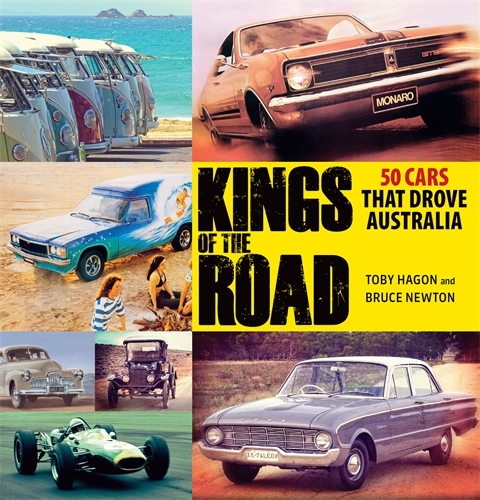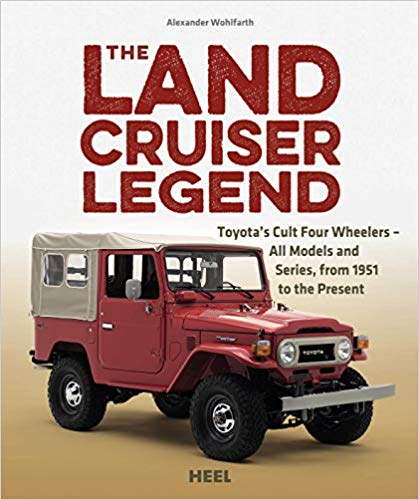Book Review by Hugh King (Chairman, AMHF)
‘Kings of the Road – 50 Cars that Drove Australia’
by Toby Hagon and Bruce Newton. Published 2018 by PanMacmillan Australia, 214 pages: ISBN 1-76055-808-6
‘The Land Cruiser Legend – Toyota’s Cult Four Wheelers’
by Alexander Wohlfarth. Published 2018 by Heel Verlag GmBH Germany, 256 pages: ISBN 978-3-95843-301-4
Two notable long-time Australian ‘muttering rotters’ (was that Bill Tuckey’s aphorism? – he was a great Australian motoring writer also) have worked up a pithy and personal list of their own hit parade of our motor heritage. ‘Kings of the Road’ is a good effort and is rather more than a well-timed Christmas stocking filler, it is a tour of the horizons of our collective memory of the fossil-fuel personal transport that developed our big nation. The authors explain their rationale in their afterword or ‘blurb’ –
‘Brands like Holden, Ford and Toyota became a part of our national identity and helped many of us define our individual personalities with vehicles such as the 48-215, the Falcon and the Landcruiser. They’re cars that have helped shape Australian culture … we’ve called them the Kings of the Road’.

This is a judgement call, and undeniably the mix they have selected does resonate with ways our Australian storytellers in the media like to depict the nation’s love affair with the car in history.
Another such effort was made fifteen years ago by another motor journalist, Kevin Norbury in his similar survey coincidentally named ‘King of the Road: Australians and Their Cars’ (Hardie Grant, Melbourne 2004). He opted for fifty-one individual cars and their then owners, telling their stories of acquisition, ownership and enjoyment of cars as diverse as a 1921 Doge Roadster, a 1974 Citroen DS21 Pallas and a 1953 Holden FX utility. I see no Japanese car makes the cut in this book.
The stories of those 51 cars and their owners in 2004 give a valid and useful report of the Australian car culture at the time, without making any special point about the national identity.
But this new 2018 selection is interesting and each car is explored in useful depth by the two expert authors. In addition to the many and various Holdens and Fords in their mix, there are a Subaru Brumby and a Mini Moke and a Bolwell, and the Goggomobil Dart as one would expect. But here’s the thing. Of the fifty cars that Toby Hagon and Bruce Newton list here, four are Toyota Land Cruisers of various vintages, and two more are of the Land Cruiser family – a RAV4 and Prado. More than ten per cent of the text is given over to the big Toyota’s place in our motor heritage. For this reviewer, it’s a remarkable score for the Land Cruiser and one that drove him to look again at the most recent books which focus on Toyota’s manufacturing nous and especially their big popular ‘Toorak Tractor’.
There are several books on Toyota now*, but my choice fell on the new (English language edition) of ‘The Land Cruiser Legend’ by German enthusiast Alex Wohlfarth. He organises the annual Bush Taxi Meet where European Land Cruiser fans gather for a few days of “Toyotal madness” – which seems to be the Deniliquin Ute Muster but with tidy German rules and regulations. He knows his subject.

Wohlfarth clearly enjoys his hobby and his Land Cruisers. His book reflects both the thoroughness and the quirkiness that we all enjoy in any special work like this one which deals with themes of social history. The corporate origins, the early links with the Japanese military, the numerous attempts to conquer the American markets in the face of post-war prejudices against Japanese products in the 1950s are explored and explained with humour and clarity.
The author’s humour is nice. The ‘F’ engine introduced in the FL21 in late 1955 is a ‘monumental chunk of cast iron whose genes have been passed down to the present day …. considered raw, indestructible, unstoppable underhood life insurance’. ‘We will know how long it lasts when the first one wears out’. And then, after describing an inscrutable classification decision the author says – ‘Well, the cognoscenti of Toyotadom have long suspected that hidden behind this nomenclature was a clever strategy on the road to total world domination. Pondering any deeper meaning will …. result in seized pistons in the frontal lobes. And while we are all incapacitated by this puzzle, Toyota will flood the world market with red Corolla hatchbacks with brown velour upholstery’. Yes! Shades of the great Bill Tuckey!
There is useful and searchable guidance on the maze of model designations and the changes effected over the several generations of the Land Cruiser. Wohlfarth gives us lists, and indexes, and facts, diagrams and links and clues and footnotes and technical explanations, and they all come together as a readable, accessible whole.
Toyota is forever a disciple of the Japanese practice of kaizen – which starts on the premise that the status quo is never acceptable and is always in need of improvement; no sudden discontinuous change but systematic optimisation of products, design and internal work environment. In this Toyota reflects the philosophies of the larger German manufacturers in particular, and now the South Korean majors are following suit. Toyota began on this trail in the 1950s, the gene pool is described and so we see why the present Land Cruiser is recognised now for the durability, the heavy reliable quality of its many forebears. Robust over-engineering was, and is, a feature always attracting the core customers for the Land Cruiser family, including the buyers who will never test it.
The Land Cruiser has seemingly been with us here since pre-history but in fact the first one was off-loaded from the boat in July 1959 and ‘put to work within the framework of Australia’s most important development project of the time’ a.k.a. the Snowy Mountains Hydro-Electric Scheme. The immediate success of the Land Cruisers in this role led to Sir Leslie Thiess seizing the agency rights and promoting sales in all cities. So for sixty years now the Land Cruiser has been woven into our motoring heritage with its earned reputation for durability and kaizen engineering practices.

